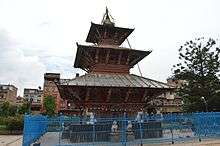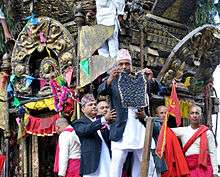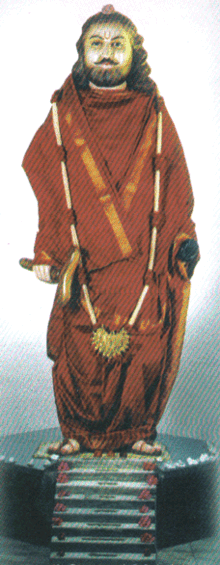Matsyendranath
| Matsyendranatha मत्स्येन्द्रनाथ मछिन्द्रनाथ बुंग द्यः | |
|---|---|
|
Matsyendranātha | |
| Born |
10th century c.e Kamarupa[1] |
| Founder of | Nath, Hatha yoga |
| Denomination | Nath, Kaula shaivism |
| Philosophy | Hatha yoga, Tantra |
| Notable disciple(s) | Gorakshanath, Jalandharnath, Kanifnath (Kanhoba), Gahininath, Bhartrinath, Revan Nath, Charpatinath and Naganath |
| Kaulajnan-Nirnaya, Akul-Viratantra[2] | |
| Part of a series on | ||
| Hindu philosophy | ||
|---|---|---|
 | ||
| Orthodox | ||
|
|
||
| Heterodox | ||
|
|
||
|
||
Matsyendranātha, Macchindranāth or Mīnanātha (Newari Buṅga Dyaḥ, c. early 10th century) was a saint and yogi in a number of Buddhist and Hindu traditions. He is traditionally considered the founder of hatha yoga as well as the author of some of its earliest texts. He is also seen as the founder of the natha sampradaya, having received the teachings from Shiva.[3] He is especially associated with kaula shaivism.[4] He is also one of the eighty-four mahasiddhas and considered the guru of Gorakshanath, another important figure in early hatha yoga. He is revered by both Hindus and Buddhists, and is sometimes regarded as an incarnation of Avalokiteśvara.
Early life
Little is known about the life of Matsyendra and legends vary in describing his birthplace and his son is Minanatha and he is also associated with Lui-Pa, all of whose names translate as 'Lord of the Fishes'.[5] Giuseppe Tucci states, on the authority of two Tibetan works - the Siddha (Wylie: grub thob ) and Taranatha's "Possessing the Seven Transmissions" (Wylie: bka' babs bdun ldan ) - that Matsyendranāth, who is seen in Tibet as an avatar of Avalokiteśvara, was a fisherman from Kamarupa.[1][2][6] [7][8] Other sources give his birthplace as Bengal.[2][9] The Newar people of Nepal claim his birthplace is Bungamati near Kathmandu.[10] He is mentioned in the Sabaratantra as one of the twenty four Kapalika siddhas.[1]
Legend
Legends tell that Matsyendra was born under an inauspicious star. This warranted his parents to throw the baby into the ocean. It is here that the baby was swallowed by a fish where he lived for many years. The fish swam to the bottom of the ocean where Shiva was imparting the secrets of yoga to his consort, Parvati. Upon overhearing the secrets of yoga, Matsyendra began to practice yoga sadhana inside the fish's belly. After twelve years he finally emerged as an enlightened Siddha. This is often given as the origin of his name 'Lord of the Fishes' or 'He Whose Lord is the Lord of the Fishes'.[11] Other versions of the legend exist, including one in which Matsyendra was born as a fish and turned into a siddha by Shiva.[12] Tibetan renditions of the story tell of a fisherman turned siddha named Mina who is eaten by a fish while working in the Bay of Bengal.[13] Some scholars draw parallels between this legend and the Biblical story of Jonah and the Whale.[14]
Another legend says that, when Gorakshanath visited Patan, he captured all the rain-showering serpents of Patan and started to meditate after he was disappointed by the locals as they did not grant him any alms on his request. As a result, Patan faced drought for a long time. The king of Patan, on the advice of his advisers, invited Matsyendranath, Gorakshanath's guru, to Patan. When Gorakhnath learned that his teacher was in Patan, he released all the rain showering serpents and went to see him. As soon as the rain showering serpents were set free, Patan again got plenty of rainfall every year. After that day, the locals of Patan worshiped Matsyendranath as the god of rain.[15][16]
Works
Matsyendra is credited with composing hatha and tantric works such as the Kaulajñānanirnāya ("Discussion of the Knowledge Pertaining to the Kaula Tradition"),[17] the Matsyendrasamhita and "Akula-Viratantra", some of the earliest texts on hatha yoga in Sanskrit in the eleventh century.[2] James Mallinson, Alexis Sanderson, David Gordon White and others theorize that many works were attributed to him posthumously.[18][19] He was known to be sympathist of hermits and occultists.[20] Matsyendranath did a lot to bring about social and religious awakening by combining the best in Buddhism and Hinduism.[21]
Disciples
Matsyendranath is typically listed as having eight disciples. The list of his disciples varies between different temples and lineages,[22] but commonly includes Gorakshanath, Jalandharnath, Kanifnath (Kanhoba), Gahininath, Bhartrinath, Revan Nath, Charpatinath and Naganath. Along with Matsyendranath, they are called the Navnath.[23] While Gorkshanath is generally considered a direct disciple of Matsyendranath, it is likely they lived hundreds of years apart.[19]
Matsyendranath in Nepal

Macchindranāth (or Bunga Dyah in Newari) is a god of rain worshiped by both Hindus and Buddhists in Nepal. Hindus regard him as an incarnation of Shiva while Buddhists regard him as an incarnation of Avalokiteśvara. The temple of Macchindranāth lies in the southern part of the Patan Durbar Square since 1673.[24]
Rato Matsyendranath of Patan, Nepal

Hyangu (red) Macchindranath temple in Patan,[25] also known as the Rato Macchindranath Temple, is one of the oldest Matsyendranath temples, dating back from the 16th century.[26] It lies in the southern part of the Patan Durbar Square. Each of the four well crafted wooden doors of this temple is guarded by two lion figures while the four corners of the temple are guarded by khyah, a yeti-like figure.[24] The murti of Rato Macchindranath (Matsyendranath) spends six months of the year in this temple. The village of Bungamati, regarded in Nepal as the birthplace of Matsyendranath, is a traditional Newar town located 10 kilometres (6.2 mi) from downtown Kathmandu. The temple of Rato Macchindranath is located in the heart of this village and it is known as his second home.[26] After the chariot festival, Rato Macchindranath spends the next six month in this temple.
Seto Matsyendranath of Kathmandu, Nepal
Toyu (white) Macchindranath temple in Kathmandu in another important Macchindranath temple in Nepal. White Machhindranath(Matsyendranath) is also known as Jana-baha Dyo since the temple is located at Jana Baha(Bahal).[27]
Bhote Jatra (भोटे जात्रा)/ Chariot festival


The most important event connected with the deity is the annual chariot procession known as Bunga Dyah Jatra or Rato Macchindranath Jatra. Each year, the locals of Patan, Lalitpur celebrate the festival in order to show respect to the rain god. This festival is one of the oldest and the longest festival celebrated in Patan and is celebrated in April–May.[15][28]
It is celebrated just before the monsoon season starts so that the city will get plenty rainfall for good growth of crops. During the procession, the image of Bunga Dyah is placed on a tall chariot about 65 feet high and pulled in stages through the streets of Patan for a month.
Before the chariot festival starts the ritual of Mahasnana is conducted in an auspicious hour as indicated by the astrologers about 15 days before the chariot festival. The deity is taken to a platform at Lagankhel which is about 200 meters away from the temple of Machindranath at Ta: bahal Lalitpur. There in front of a huge crowd the god is given a bath with the sacred water mixture of honey, milk and water fetched by the panejus or priests in the four silver kalasa(vessel). The four priests then pour the sacred water or jal from four direction in the platform to the deity and it is believed that from which ever direction 1st the jal touches the deity from the same direction monsoon will start or first rain will be granted.
After the mahasnana the repairs are done to the idol of the deity if required and the new face is painted. After the face painting is over various ritual are performed to the deity like Bareychukegu; Ihi; Bara tyegu as done to a human and at the end Dashakarma vidhi is performed. While these all are going on the temple premises, the chariot or ratha is made at Pulchowk by the Barahi and Yawal clans, amongst which one only does the rope work and other only the wood work. In the construction of the chariot no nails are used to connect the joints of the huge chariot but are only tied with ropes and veds. The only part that uses iron to hold are the four wheels. After the construction is finished the deity is ascended in the divine vehicle i.e. 3 days before the pulling of chariot.
The route of the chariot procession starts at Pulchwok and passes through Gabahal, Sundhara, Lagankhel and ends at Jawalakhel.Previously the festival was called the festival of three states viz. Kathmandu, Bhaktapur, Lalitpur as the deity was brought by the alliance of these three states. So, previously the 1st day of festival was to be carried on by people of Kathmandu then by Bhaktapur and then 3rd by Lalitpur, and on last day all three sister cities come together for Jawalakhel jatra with other nearby city people from Kirtipur and others from the valley.[15]
After the chariot reacher Jawalakhel, this festival concludes with Bhoto Jatra, which literally means "vest festival". During the ceremony, a government official holds up a sacred jewel-studded black vest from the four sides of the chariot so that all the people gathered around can have a look at it.[29]
After the festival, the chariot is dismantled and Rato Macchindranath is taken to a temple in the nearby village of Bungamati, also known as the second home of the rain god. Rato Macchindranath spends the next six months in that temple.[30]
Matseyendranath Temples in India
- The samadhi place of Machindranath, Ujjain, Madhya Pradesh
- Macchindranath temple in kille-Machhindragad Tal: Walwa (Islampur) Dist: Sangli, Maharashtra
- Vishwayogi Swami Machindranath Mandir, Mitmita: Aurangabad
- Mayamba Temple (Garbhagiri Pravat as mentioned in Navnath Grantha) at Shri Kshetra Machindranath Devasthan at Sawargaon: Tal: Ashti, District: Beed
- Machhindra Nath Mandir, Inside Ambagate, Amravati
- Machindra Nath Tapobhumi,Devacho Dongar, Kudal, Maharashtra, Dist Sindhudurg.(This Holy place is mentioned in the 6th Chapter of Navnath Grantha)
- Macchendranath Guru Peeth in Sri Guru Parashakthi Kshethra: Madyar: Mangalore
In popular culture
In the Dasam Granth, Guru Gobind Singh narrated a huge discourse between Matsyendra Nath and Paras Nath on Intuitive (Bibek) and Non Intuitive Mind (Abibek). Parasnatha subdued kings of the world and turned egoistic, and was broken by Matsyendranatha's spiritual preachings. This granth is regarded among Spiritual warriors of Khalsa Panths called Nihang Singhs.
There are a few films about this legend in Indian cinema.
- The first film entitled Maya Machhindra was made in 1932 in Hindi and Marathi languages by Prabhat Film Company and directed by V. Shantaram. Govindrao Tembe portrayed the role of Machhindranath.[31]
- The second film (of the same title) was made in 1939 in the Tamil language directed by Raja Chandrasekhar and starring N. S. Krishnan and M. G. Ramachandran.[32]
- The third film in the Telugu language, also title Maya Machhindra, was made P. Pullaiah in 1945 starring Jandhyala Gourinatha Sastry, Addanki Srirama Murthy and Pasupuleti Kannamba.[33]
- The fourth film was again made in Hindi and Marathi languages in 1951 directed by Aspi Irani.
- The fifth film was made in Hindi language by Babubhai Mistry in 1960/61.
- The sixth film was made in Telugu language in 1975 starring N. T. Rama Rao and directed by Kamalakara Kameswara Rao.
References
- 1 2 3 "Asiatic Society (Calcutta, India)". Journal and Proceedings of the Asiatic Society of Bengal. XXVI (1): 133
–141. 1930. line feed character in
|pages=at position 4 (help) - 1 2 3 4 Suhas Chatterjee (1998), Indian Civilization and Culture, P.441 Vajrayana Buddhist cult flourished in Kamarupa in the 10th century. It is locally known as Sahajia cult. The celebrated Buddhist monk Minannatha of Tibet happeneed to be a son of a fisherman of Kamarupa. However, some scholars say that Minanatha was a native of Bengal. Another monk in Tibet, Rahula was an Assamese from Kamarupa. Akulaviratantra, a text on tantra worship was compiled by Minanatha.
- ↑ Feuerstein, Georg (2013-09-11). The Yoga Tradition: It's History, Literature, Philosophy and Practice (Kindle Locations 12788-12789). Hohm Press. Kindle Edition. "Matsyendra was a chief representative, if not the originator, of what is known as Nâthism. But Shiva himself is considered as the source of the Nâtha lineage and is invoked as Adinâtha or 'Primordial Lord.'" (Kindle Locations 12825-12827). "Using his third eye, Shiva gazed straight through the mountain of flesh into the fish’s stomach, where he saw Mina. He was thrilled at the discovery, saying, “Now I see who my real disciple is.” Turning to his sleepy spouse, he said: “I will initiate him rather than you.”"
- ↑ Feuerstein, Georg (2013-09-11). The Yoga Tradition: It's History, Literature, Philosophy and Practice (Kindle Locations 12803-12804). Hohm Press. Kindle Edition. "He is specifically associated with the Kaula sect of the Siddha movement, within which he may have founded the Yoginî-Kaula branch."
- ↑ The Alchemical Body: Siddha Traditions in Medieval India" by David Gordon White, p. 91
- ↑ Kamrupa Anusandhana Samiti (1984), Readings in the History & Culture of Assam,p.201 it is stated that a Siddha, named Minanatha, was a fisherman from Kamarupa
- ↑ Institute of Nepal and Asian Studies, Tribhuvan University, Nepal (1996), Contributions to Nepalese studies - Volumes 23-24,Page 93 Matsyendra was a resident of Kamrup-Kamakhya (today's Assam in East India).
- ↑ Pandit, M. M.; Shastri, H. P. Bauddha Gan O Doha.
- ↑ Feuerstein, Georg (2013-09-11). The Yoga Tradition: It's History, Literature, Philosophy and Practice (Kindle Locations 12785-12786). Hohm Press. Kindle Edition. "Hindu tradition associates the creation of Hatha- Yoga with Goraksha Nâtha (Hindi: Gorakhnâth) and his teacher Matsyendra Nâtha, both of whom were born in Bengal."
- ↑ Rato Matsyendranath of Patan and Bungamati, Tribhuvan University. Institute of Nepal and Asian Studies, 1973 by John Kerr Locke
- ↑ http://www.lorinroche.com/yoga/yoga/matsyendra.html
- ↑ Light on Yoga, BKS Iyengar
- ↑ Feuerstein, Georg (2013-09-11). The Yoga Tradition: It's History, Literature, Philosophy and Practice (Kindle Locations 12817-12820). Hohm Press. Kindle Edition. "In the Tibetan hagiography of the eighty-four mahâ-siddhas, the following story is told of Mina Nâtha (who probably is identical with Matsyendra). The fisherman spent most of his time in his small boat in the Bay of Bengal. One day, he hooked a huge fish that pulled so hard on his fishing line that he was thrown overboard. Like Jonah in the biblical story, Mina ended up in the fish’s enormous stomach, protected by his good karma."
- ↑ Buddhist Reflections By Lama Anagarika Govinda, Maurice O'Connell, ISBN 978-81-208-1169-0, p.119
- 1 2 3 When does the procession of Rato Macchendranath of Patan take place? (2007, 28 Oct). Retrieved from http://exoticbuddha.com/when-to-go/festivals/when-does-the-procession-of-rato-machhendranath-take-place
- ↑ Rato machendraNath Festival: Month-long chariot procession over. (2011, 26 June). Retrieved from http://www.ekantipur.com/the-kathmandu-post/2011/06/25/metro/rato-machendranath-festival-month-long-chariot-procession-over/223276.html
- ↑ Bhattacharya, edited by Gerald James Larson, Ram Shankar (2008). Yoga : India's philosophy of meditation (1st ed.). Delhi [India]: Motilal Banarsidass Publishers. p. 436. ISBN 978-8120833494.
- ↑ "Hathayoga's Philosophy: A Fortuitous Union of Non-Dualities" by James Mallinson, University of Oxford
- 1 2 "Saktism and Hathayoga" by James Mallinson, 6th March 2012
- ↑ Devdutt Pattanaik (2009), Seven Secrets from Hindu Calendar Art,p.150-151
- ↑ History of Hindi language and literature (1978), Page 36 Matsyendranath did a lot to bring about social and religious awakening by combining the best in Buddhism and Hinduism. The best known preacher of this cult was, however, Gorakhnath who was a disciple of Matsyendranath.
- ↑ The Alchemical Body: Siddha Traditions in Medieval India" by David Gordon White, p. 92
- ↑ Frydman, Maurice (1987). "Navanath Sampradaya". In Dikshit, Sudhakar S. I Am That: Talks With Sri Nisargadatta Maharaj. Acorn Press. ISBN 9780893860462.
- 1 2 Lonely Planet review for Rato Machhendranath Temple. (n.d.). Retrieved from http://www.lonelyplanet.com/nepal/around-the-kathmandu-valley/patan/sights/religious-spiritual/rato-machhendranath-temple
- ↑ "Historical Monuments & WHS". Lalitpur.org.np. Lalitpur Sub-Metropolitan City Office. Retrieved 2015-03-22.
- 1 2 Rato Macchendranath Temple. (2013, 19 Feb). Retrieved from http://buddhanepaltrek.blogspot.com/2013/02/rato-machhendranath-temple.html
- ↑ http://arkonetwork.com/news/nepal/seto-machhindranath-chariot-procession-concludes/
- ↑ Rato Macchendranath Jatra – The Rain God’s Chariot Festival Begins. (2011, 8 May). Retrieved from http://www.explorehimalaya.com/blog/rato-machhendranath-jatra-the-rain-god%E2%80%99s-chariot-festival-begins/
- ↑ "Bhoto Jatra marked amid much fanfare". The Kathmandu Post. 28 June 2011. Retrieved 23 May 2013.
- ↑ Rato (Red) Machhendranath. (n.d.). Retrieved from http://encyclopedia2.thefreedictionary.com/Rato+Machhendranath
- ↑ Maya Machhindra (1932) at the Internet Movie Database
- ↑ Maya Machhindra (1939) at the Internet Movie Database
- ↑ Maya Machhindra (1945) at the Internet Movie Database
Further reading
- Mahendranath, Shri Gurudev. "Ecstasy, Equipoise, and Eternity". Mahendranath.org. International Nath Order. Retrieved 2015-03-22.
- Mahendranath, Shri Gurudev. "Notes on Pagan India". Mahendranath.org. International Nath Order. Retrieved 2015-03-22.
External links
- http://exoticbuddha.com/when-to-go/festivals/when-does-the-procession-of-rato-machhendranath-take-place
- http://www.lonelyplanet.com/nepal/around-the-kathmandu-valley/patan/sights/religious-spiritual/rato-machhendranath-temple
- http://encyclopedia2.thefreedictionary.com/Rato+Machhendranath
- http://www.explorehimalaya.com/blog/tag/rato-machhendranath-jatra/
- http://buddhanepaltrek.blogspot.com/2013/02/rato-machhendranath-temple.html
